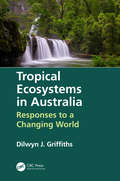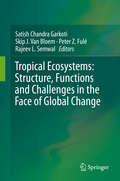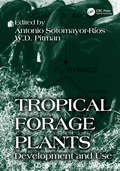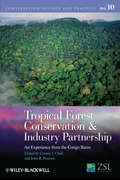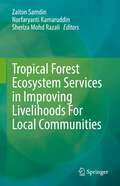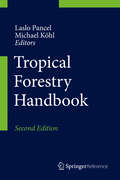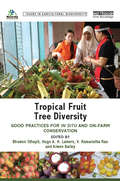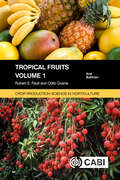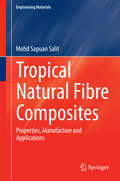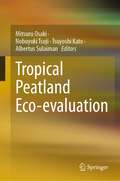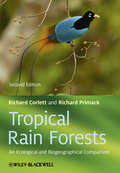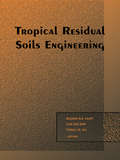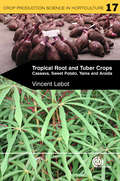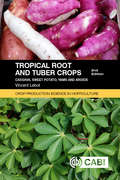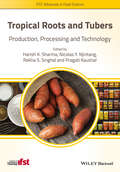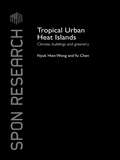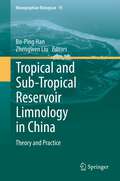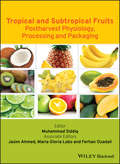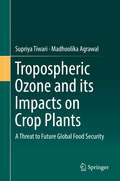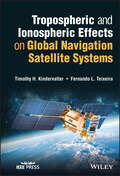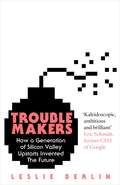- Table View
- List View
Tropical Ecosystems in Australia: Responses to a Changing World
by Dilwyn GriffithsOver the last century, the world has lived through changes more rapid than those experienced at any other time in human history, leading to pressing environmental problems and demands on the world’s finite resources. Nowhere is this more evident than across the world’s warm belt; a region likely to have the greatest problems and which is home to some of the world’s most disadvantaged people. This book reviews aspects of the biology of tropical ecosystems of northern Australia, as they have been affected by climatic, social and land-use changes. Tropical Australia can be regarded as a microcosm of the world’s tropics and as such, shares with other tropical regions many of the conflicts between various forms of development and environmental considerations. The book draws on a wide range of case studies of tropical Australian ecosystems ranging from coastal coral reefs and mangroves, known to be among the most vulnerable to the effects of the imposed changes, to cropping and pasture lands which, under careful management, have the potential remain as productive and sustainable agricultural or forestry ecosystems. Expert author Dilwyn Griffiths -emphasizes the importance of maintaining an active program for the establishment and management of national parks and environmental reserves -describes the effects of mining and other forms of industrial and urban development with particular reference to mine-site rehabilitation - explores problems relating to the restoration of marginally uneconomic farming land as alternative forms of land-use such as carbon farming through photosynthetically-driven carbon sequestration. This accessible reference work should find a place in educational libraries at all levels and become an essential resource for environmentalists and anyone with interests in various forms of land-use and development.
Tropical Ecosystems: Structure, Functions and Challenges in the Face of Global Change
by Satish Chandra Garkoti Skip J. Van Bloem Peter Z. Fulé Rajeev L. SemwalThe book brings together research topics having a broad focus on human and climate change impacts on the terrestrial ecosystems in the tropics in general and more specifically from the most significant and vulnerable Himalayan ecosystem. A total of 16 contributions included in the book cover a diverse range of global change themes such as the impacts of changing temperature and precipitation on soil ecosystems, forest degradation, extent and impacts of invasive species, plant responses to pollution, climate change impacts on biodiversity and tree phenology, environmental changes associated with land use, importance of traditional knowledge in climate change adaptation, timberline ecosystems, and role of integrated landscape modeling for sustainable management of natural resources. The book is a collective endeavour of an international multidisciplinary group of scientists focused on improving our understanding of the impacts of global change on the structure and functioning of tropical ecosystems and addressing the challenges of their future sustainable management. We hope that the book will help researchers working in the areas of ecology and environmental science to update their knowledge. We also expect that natural resource managers and policy planners will find explanations for some of their observations and hypotheses on multiple global change factors impacting tropical ecosystems and especially Himalayan ecosystems.
Tropical Forage Legumes: Harnessing the Potential of Desmanthus and Other Genera for Heavy Clay Soils
by Nazeer Ahmad John R. LazierThe development of legume use in agricultural production in the tropics lags far behind the temperate areas and extensive research over recent decades has aimed to rectify the lack of available leguminous fodder species available for heavy clay soils. This book draws together that research and explores the importance of heavy clay soils to agricultural productivity in the tropics and subtropics and the identification of adapted, productive forage legumes for these environments. Covering over four decades of international research, Tropical Forage Legumes: · Includes a detailed analysis of the forage germplasm available which is adapted to heavy clay soils · Covers the adaptation of a wide range of forages on Australian clay soils, and the evaluation of successful native and exotic forage legume species that have potential for those in Belize · Explores the genetics of the most promising genera, Desmanthus and Stylosanthes, and looks at the results from countries where new genotypes have been found to be productive and persistent · Provides details of a number of exciting new species, especially those in Desmanthus which have the potential to be, or have been commercialized · Makes recommendations for future research Providing an invaluable example of how a global search for adapted and productive forage germplasm has been - and can be - undertaken, and allowing access to a significant body of knowledge that was acquired before the digitalization of reports, this book will be a key resource for new scientists and experienced researchers in the areas of agriculture and forage agronomy.
Tropical Forage Plants: Development and Use
by W. D. Pitman Antonio Sotomayor-RiosTropical Forage Plants: Development and Use covers the research and resulting pasture development in the tropics and subtropics, which has undergone dramatic changes in the past few decades. Providing a broad, global perspective, it serves as a comprehensive resource covering a wide range of subjects pertaining to forage and animal production in th
Tropical Forest Biomes (Greenwood Guides to Biomes of the World)
by Barbara A. HolzmanThe book is arranged with a general introduction to tropical forest biomes and chapters on the Tropical Rainforest Biome and Regional Expressions of the Tropical Rainforest Biome, and the Tropical Seasonal Forest Biome and Regional Expressions of the Tropical Seasonal Forest Biome.
Tropical Forest Conservation and Industry Partnership: An Experience from the Congo Basin (Conservation Science and Practice #14)
by Connie J. Clark John R. PoulsenHistorically, the conservation of forests and wildlife has focused on the creation of national parks and reserves. However, only 9% of protected areas are larger than 14,000 hectares, likely making them too small to conserve ecosystem services and prevent loss of wide-ranging keystone species such as elephant and leopard. New approaches are needed that extend conservation beyond protected area boundaries into areas where economic considerations prevail. The book describes one such emerging model of conservation: the integration of the private sector into partnerships to protect biodiversity and improve forest management. While such partnerships are being created in nearly every sector of resource extraction, detailed analyses of how such partnerships work and whether they benefit biodiversity conservation are rare. Using a case study from the Congo Basin, the book examines principles of conservation and partnership, and provides technical and methodological details to replicate an innovative conservation model. It presents concrete solutions for expanding conservation across multi-use landscapes, a necessary action as industry expands to all the corners of the globe.
Tropical Forest Ecosystem Services in Improving Livelihoods For Local Communities
by Norfaryanti Kamaruddin Zaiton Samdin Sheriza Mohd RazaliThis edited book covers major importance of tropical forest diversity and its values to vegetation, wildlife, and the local community. It addresses the current issues and opportunities in the Southeast Asia’s tropical forests. This book lays the groundwork for a better understanding of tropical forest ecosystem services. Ecosystem services has four concepts: provisioning, regulating, cultural and supporting services. In an era of rapid population growth and increasing pressure on tropical natural resources, ecosystem services have become central to the discussion of climate change mitigation. The values of tropical forest ecosystem services deserve to be the highlighted when it comes to shaping responsible behaviors towards sustainable development goals (SDGs). This book is of interest and useful to researchers and academics teaching in the field of tropical forest conservation, tropical ecosystems, tropical products technology, ecotourism, forest plantation management, bio industrial economy, agroforestry business and marketing. Professionals, foresters, industrial entrepreneurs, ecologists, and a valuable source of reference to the relevant researchers and students in the region.
Tropical Forestry Handbook
by Michael Köhl Laslo PancelThis book provides a cross-section of all outstanding experience in all fields of tropical forestry under a drastically changing environment induced by climate change. It sheds light on the existing know-how and presents it in a concise and efficient way for the scientist and professional in charge of planning, implementing and evaluating forest resources. The Tropical Forestry Handbook provides proven and/or promising alternative concepts which can be applied to solve organizational, administrative and technical challenges prevailing in the tropics. Presented are state of the art methods in all fields concerning tropical forestry. Emphasize is given to methods which are adapted to- and which safeguard - environmental conditions.
Tropical Fruit Tree Diversity: Good practices for in situ and on-farm conservation (Issues in Agricultural Biodiversity)
by Bhuwon Sthapit Hugo Lamers Ramanatha Rao Arwen BaileyFarmers have developed a range of agricultural practices to sustainably use and maintain a wide diversity of crop species in many parts of the world. This book documents good practices innovated by farmers and collects key reviews on good practices from global experts, not only from the case study countries but also from Brazil, China and other parts of Asia and Latin America. A good practice for diversity is defined as a system, organization or process that, over time and space, maintains, enhances and creates crop genetic diversity, and ensures its availability to and from farmers and other users. Drawing on experiences from a UNEP-GEF project on "Conservation and Sustainable Use of Wild and Cultivated Tropical Fruit Tree Diversity for Promoting Livelihoods, Food Security and Ecosystem Services", with case studies from India, Indonesia, Malaysia and Thailand, the authors show how methods for identifying good practices are still evolving and challenges in scaling-up remain. They identify key principles effective as a strategy for mainstreaming good practice into development efforts. Few books draw principles and lessons learned from good practices. This book fills this gap by combining good practices from the research project on tropical fruit trees with chapters from external experts to broaden its scope and relevance.
Tropical Fruits, Volume 1 (Crop Production Science in Horticulture)
by Robert E Paull Odilo DuarteOver the past few years there has been an increase in the variety of tropical fruits available for consumption, due to improved breeding, postharvest management and distribution systems. The production and world trade of fresh tropical fruits is expected to expand further, aided by consumer demand for healthy diets and for trying new foods. The third edition of this book covers major tropical fruits such as avocado, banana, litchi, mango, papaya, and pineapple. The first five chapters describe general aspects of the tropical climate and its soils, fruit production techniques, tree management, and postharvest handling. Following these are self-contained chapters on single fruits that provide in-depth studies of botany, taxonomy, varieties, propagation, orchard management, biotic and abiotic problems, and utilization. The ancient and modern propagation and cultural practices are described to show the regional differences that environmental and biological pressures exert on fruit production and fruit quality. Tropical Fruits 3rd edition is essential reading for students and teachers of horticulture and tropical agriculture, as well as for horticultural industry personnel.
Tropical Natural Fibre Composites
by Mohd Sapuan SalitThis book covers the different aspects of tropical natural fibre composites in areas such as properties, design and analysis, manufacturing techniques, material selection of kenaf, oil palm, sugar palm, pineapple leaf, coconut, sugarcane and banana based fibre composites. Important properties such as mechanical and thermal of natural fibres as well their composites are presented. A study on the composite fibre-matrix interface is highlighted together with the design process and analysis of products from natural fibre composites. An overview on the manufacturing techniques (conventionally used to produce fibre glass fibre composites) such as pultrusion and filament winding is described to produce natural fibre composites. The importance of material selection system to obtain the most optimum materials for application in engineering components from natural fibre composites is covered with a strong focus on the concurrent engineering for natural fibre composites.
Tropical Peatland Eco-evaluation
by Mitsuru Osaki Nobuyuki Tsuji Tsuyoshi Kato Albertus SulaimanThis book focuses on eco-evaluation system monitoring and sensing, carbon-water modeling, mapping, and disaster prediction. It is the 3rd book on tropical peatland issues, following 1st "Tropical Peatland Ecosystem" and 2nd "Tropical Peatland Eco-management" publications. Tropical peatland is also a wetland, mangrove, and rainforest. With this nature, two major key elements of tropical peatland are water and forest. This book introduces the relationship and interaction among water, oxygen, and nutrients as well as aspects of the forest as the driving force of carbon stock and the carbon cycle. Eco-evaluation system is key to conserving, managing, and restoring tropical peatlands, however comprehensive system for Eco-evaluation in the Tropics is not yet established. This book reviews and proposes Eco-evaluation methods in the Tropics Ecosystem, focusing mainly on the peatland ecosystem and others, covering Social Capital such as Credit, Bonds, National Accounting, etc.
Tropical Peatland Eco-management
by Mitsuru Osaki Nobuyuki Tsuji Nazir Foead Jack RieleyIn this "Tropical Peatland Eco-management" book, eco-management is new terminology as an abbreviation of "ecology-based management for natural capital enhancement". Key concept on this eco-management is derived from previous book: "Tropical Peatland Ecosystem"(Springer, 2015, eds. by M. Osaki and N. Tsuji). Based on this new concept, this book thoroughly examines tropical peatland eco-management for scientists, political decision makers, governmental officials, land managers, students, and NGO/NPOs who are interested in 1) what the impact of peatland on climate change and ecosystem function, 2) how the management of disturbed peatland, and 3) drawing global scale restoration mechanisms of peatland and wetland. In tropical peatland, a large amount of GHGs (carbon dioxide, methane, and nitrous oxide) is emitted due to the unappropriate development and inadequate management of peatland. The peatland ecosystems consist of the carbon–water complex, which is affected easily by the impact of human and climate change. Throughout much research of tropical peatland, the problems that result from development of tropical peatland are found to stem mainly from a lack of understanding of the complexities of this ecosystem and the fragility of the relationship between peat and forest and also between carbon and water. In past, almost all peatland development and management system have been generally designed on “water drainage system”. On the contrast of old system, an innovated eco- management is, here, proposed as “water irrigation system”, including water cycling and natural capital enhancement. Through this book readers will learn the advanced peatland eco-management, with more practical methods and procedure based on ecosystem knowledge.
Tropical Rain Forests: An Ecological and Biogeographical Comparison
by Richard T. Corlett Richard B. PrimackThe first edition of Tropical Rain Forests: an Ecological and Biogeographical Comparison exploded the myth of ‘the rain forest’ as a single, uniform entity. In reality, the major tropical rain forest regions, in tropical America, Africa, Southeast Asia, Madagascar, and New Guinea, have as many differences as similarities, as a result of their isolation from each other during the evolution of their floras and faunas. This new edition reinforces this message with new examples from recent and on-going research. After an introduction to the environments and geological histories of the major rain forest regions, subsequent chapters focus on plants, primates, carnivores and plant-eaters, birds, fruit bats and gliding animals, and insects, with an emphasis on the ecological and biogeographical differences between regions. This is followed by a new chapter on the unique tropical rain forests of oceanic islands. The final chapter, which has been completely rewritten, deals with the impacts of people on tropical rain forests and discusses possible conservation strategies that take into account the differences highlighted in the previous chapters. This exciting and very readable book, illustrated throughout with color photographs, will be invaluable reading for undergraduate students in a wide range of courses as well as an authoritative reference for graduate and professional ecologists, conservationists, and interested amateurs.
Tropical Residual Soils Engineering
by Bujang B. K. Huat Gue See Sew Faisal Haji AliFocused on tropical areas and their unique problems and issues, this work examines all aspects of residual soils engineering, including both theoretical and practical aspects. This book gives the practitioner a thorough understanding of the characteristics of these soil types, their formation and their material properties, while guidelines on appli
Tropical Root and Tuber Crops: Cassava, Sweet Potato, Yams and Aroids
by Vincent LebotMost of the world's poorest smallholders depend on tropical roots and tubers crops as their principal source of food and nutrition. These species produce large quantities of dietary energy and have stable yields under difficult environmental conditions. The most important crops are cassava, sweet potato, yam and the aroids, sharing important common traits such as bulkiness, post-harvest perishability and vegetative propagation. This book compiles the most up-to-date information on the origin, genetics, physiology, agronomy, pests and diseases and postharvest processing of these crops, while attempting to provide ideas for further research and development.
Tropical Root and Tuber Crops: Cassava, sweet potato, yams and aroids (Crop Production Science in Horticulture #No. 17)
by Vincent LebotRoot and tuber crops are important to agriculture, food security and income for 2.2 billion people in developing countries. These species produce large quantities of dietary energy and have stable yields under difficult environmental conditions. This second edition of Tropical Root and Tuber Crops is an authoritative treatment of four important root and tuber crops: cassava. sweet potato, yams, and aroids. The same format is followed for each crop: Origin and History, Taxonomy and Botany, Breeding and Genetics, Developmental Physiology, Agronomy, Pests and Diseases, Post-Harvest Quality and Marketing. This new edition reviews the scientific literature produced during the last decade and presents major technical advancements. Modern molecular tools have been used to clarify the phylogeny, taxonomy and origin of these species. Similar advances have been made in physiology, agronomy, pathology and product chemistry. It is essential reading for students, researchers and horticulturists.
Tropical Roots and Tubers: Production, Processing and Technology
by Rekha S. Singhal Nicolas Y. Njintang Pragati Kaushal Harish K. SharmaRoots and tubers are considered as the most important food crops after cereals and contribute significantly to sustainable development, income generation and food security especially in the tropical regions. The perishable nature of roots and tubers demands appropriate storage conditions at different stages starting from farmers to its final consumers. Because of their highly perishable nature, search for efficient and better methods of preservation/processing have been continuing alongside the developments in different arena. This book covers the processing and technological aspects of root and tuber foods, detailing the production and processing of roots and tubers such as taro, cassava, sweet potato, yam and elephant foot yam. Featuring chapters on anatomy, taxonomy and physiology, molecular and biochemical characterization, GAP, GMP, HACCP, Storage techniques, as well as the latest technological interventions in Taro, Cassava, Sweet potato, yam and Elephant foot Yam.
Tropical Tuber Starches: Structural and Functional Characteristics
by Dr S N Moorthy Dr M S Sajeev Dr R P Ambrose R J AnishThis book provides comprehensive and up-to-date knowledge relating to the morphological, structural, and functional characteristics of tuber starches, particularly in relation to their applications in food and industry. In recent years there has been significant progress and extensive research conducted on tropical root starches and especially on some of the lesser known tuber crop starches. There has also been a shift towards using biomaterials in place of synthetic materials in various applications. As researchers investigate the availability of natural products with similar properties, starch has been identified as a reliable alternative to these synthetic materials. Reflecting the growing body of research, Tropical Tuber Starches: - Explores the structure, properties and applications of tropical root and tuber starches (cassava, sweet potato, aroids, yams and other minor tuber crops) - Includes a chapter on the methodology for starch characterisation - Covers patents on starch-based products and the commercial potential of tropical root starches A valuable resource for researchers and students, plant breeders, and commercial producers working with, or considering working with, tropical tuber starches.
Tropical Urban Heat Islands: Climate, Buildings and Greenery (Spon Research)
by Yu Chen Nyuk Hien WongConventional air conditioning is not a sustainable solution to the challenge of a hot or humid climate. The climate problem is compounded in so-called Urban Heat Islands, urban areas where the air can be 3–5°C hotter than its surrounding areas and where pollution levels are consequently raised. Including a colour section with thermal images and maps, this book explores the complex relationships between climate, buildings and plants, especially in urban heat islands. These relationships bear very critically on a range of environmental issues and point to some corresponding solutions. One chapter highlights some of the extensive research work carried out in Singapore, especially investigating the thermal benefits of greenery in buildings in the urban setting. Though several books have been written on urban heat islands, this work uniquely examines the linkages between climate, buildings and plants. It forms a reference for researchers and professionals such as architects, architectural science, landscape architects, building services engineers, urban planners and urban climatologists. It may also be useful for final year undergraduates or graduate students in these disciplines.
Tropical and Sub-Tropical Reservoir Limnology in China
by Bo-Ping Han Zhengwen LiuReservoirs are specific aquatic ecosystems and have complex behaviors of both natural lakes and rivers, regulated significantly by their functions such as flood controlling, hydropower generation, irrigation and fishery. This volume offers a general description of reservoir limnology in tropical and subtropical China. It functions as a window opening to all the aquatic scientists with a main focus on reservoirs in southern China and at the same time also covering several important, large reservoirs such as the Three Gorge Reservoir and Danjiangko Reservoir. Topics discussed are zooplankton, phytoplankton and zoobenthos communities, cyanobateria, nutrient budget, sediments, biogeochemical cycling of mercury, fishery and eutrophication.
Tropical and Subtropical Fruits: Postharvest Physiology, Processing and Packaging
by Jasim Ahmed Ferhan Ozadali Maria Gloria LoboTropical and sub-tropical fruits have gained significant importance in global commerce. This book examines recent developments in the area of fruit technology including: postharvest physiology and storage; novel processing technologies applied to fruits; and in-depth coverage on processing, packaging, and nutritional quality of tropical and sub-tropical fruits. This contemporary handbook uniquely presents current knowledge and practices in the value chain of tropical and subtropical fruits world-wide, covering production and post-harvest practices, innovative processing technologies, packaging, and quality management. Chapters are devoted to each major and minor tropical fruit (mango, pineapple, banana, papaya, date, guava, passion fruit, lychee, coconut, logan, carombola) and each citrus and non-citrus sub-tropical fruit (orange, grapefruit, lemon/lime, mandarin/tangerine, melons, avocado, kiwifruit, pomegranate, olive, fig, cherimoya, jackfruit, mangosteen). Topical coverage for each fruit is extensive, including: current storage and shipping practices; shelf life extension and quality; microbial issues and food safety aspects of fresh-cut products; processing operations such as grading, cleaning, size-reduction, blanching, filling, canning, freezing, and drying; and effects of processing on nutrients and bioavailability. With chapters compiled from experts worldwide, this book is an essential reference for all professionals in the fruit industry.
Tropospheric Ozone and its Impacts on Crop Plants: A Threat To Future Global Food Security
by Supriya Tiwari Madhoolika AgrawalThe research and its outcomes presented here focuses on tropospheric or ground level ozone, in particular due to its surfacing as a major threat to crop productivity around the world. This book presents the ozone concentration data for a variety of geographical regions, examines the factors responsible for its increasing concentrations and its potential effects on physiological and biochemical responses culminating in crop productivity losses which, in turn may pose a serious threat to global food security. Beside this, certain ameliorative measures that could be adopted to assess ozone injury in plants are also discussed.Global climate change scenarios predict a significant increase in future tropospheric ozone concentration. Particular attention is therefore given to evaluate the effect of global climate change on ozone concentrations. Readers will also discover how yield losses due to ozone are related to changes in the socio-economic conditions of the society, especially in South Asian regions. Students and researchers studying crop and soil science, environmental scientists, risk assessment professionals and policy makers will find this book of interest.
Tropospheric and Ionospheric Effects on Global Navigation Satellite Systems
by Timothy H. Kindervatter Fernando L. TeixeiraTropospheric and Ionospheric Effects on Global Navigation Satellite Systems Explore atmospheric effects on radio frequency propagation in the context of Global Navigation Satellite System communication In Tropospheric and Ionospheric Effects on Global Navigation Satellite Systems, a team of distinguished researchers deliver an accessible and authoritative introduction to all scientifically relevant effects caused by the ionosphere and troposphere on GNSS RF signals. The book explores the origin of each type of propagation effect and explains it from a fundamental physical perspective. Each of the major methods used for the measurement, prediction, and mitigation of ionospheric and tropospheric effects on GNSS are discussed in detail. The authors also provide the mechanisms that drive ionization and plasma transport in the ionosphere, propagation phenomena (including scattering, absorption, and scintillations), and the predominant predictive models used to predict ionospheric propagation effects. With an emphasis on global navigation satellite systems, the book discusses the US Standard Atmosphere, a general reference model for characteristics of the unionized atmosphere. It also considers: Thorough introductions to the Global Positioning System and the principles of GNSS positioning Comprehensive explorations of tropospheric propagation and predictive models of the troposphere Practical discussions of the physics of the ionosphere, experimental observation of the ionosphere, and ionospheric propagation In-depth examinations of predictive models of the ionosphere, including group delay models for single-frequency GNSS receivers Ideal for engineers and research scientists with a professional or personal interest in geophysics, RF propagation, and GNSS and GPS applications, Tropospheric and Ionospheric Effects on Global Navigation Satellite Systems will also earn a place in the libraries of undergraduate and graduate students studying RF propagation or GNSS.
Troublemakers: How a Generation of Silicon Valley Upstarts Invented the Future
by Leslie Berlin**THE FINANCIAL TIMES BUSINESS BOOK OF THE MONTH** THE GRIPPING TALE OF THE EARLY FRONTIER DAYS OF SILICON VALLEY FROM ACCLAIMED HISTORIAN LESLIE BERLIN. 'The book is compelling as it maps out the building of the Valley, the challenges its early tech pioneers faced, as well as highlighting those who reached dizzying success only to suffer as the dot com bubble burst.' Financial Times ‘Kaleidoscopic, ambitious, and brilliant, the book draws on a dazzling cast of characters to chart the rise of the five industries that have come to define technology today and, collectively, to remake the world.’ Eric Schmidt, former CEO of Google and Executive Chairman of Alphabet, Inc.Leslie Berlin's previous work has been acclaimed by the New York Times: 'so engagingly narrated that you don't realize how much business and technology you are learning along the way.' Between 1968 and 1976, five landmark industries that shaped the modern world were launched within 30 miles of each other: personal computing, video games, biotechnology, modern venture capital and advanced semi-conductor logic. The dominant players in many of those industries - firms like Apple and Intel - had also been launched at the same time. During those early days of Silicon Valley, the first ARPANET transmission (now known as the Internet) came into a Stanford lab, universities began licensing innovations to businesses, and the Silicon Valley tech community began to develop their lobbying clout. Now, for the first time, the stories of the men and women who changed the world during these pivotal years are brought to life in rich detail by respected Silicon Valley historian Leslie Berlin. Berlin shines a light on the wild frontier days of Silicon Valley where the old rules were broken, revealing how the modern tech world was built and empires were forged. Troublemakers is a compelling story of the upstarts of Silicon Valley that will appeal to fans of HBO's Silicon Valley and Walter Isaacson's biography of Steve Jobs. Further praise for Troublemakers: ‘Leslie Berlin combines the keen observations of an historian with gorgeous writing and riveting storytelling to write the landmark book on the Valley. The interwoven lives of wonderfully iconoclastic characters bring the formative years of the Valley to life with sheer brilliance. Troublemakers is a must-read for anyone hoping to understand America’s tech capital.’Julia Flynn Siler, New York Times bestselling author of The House of Mondavi ‘Leslie Berlin has done it again. Following on her richly informative biography of Intel co-founder Robert Noyce, The Man Behind the Microchip, Berlin now brings us a definitive account of Silicon Valley’s “breakthrough years” in the 1970s. Troublemakers recounts the fascinating careers of seven little-known but enormously impactful players who shaped the Valley’s unique high-tech ecosystem. As entertaining as it is authoritative, Troublemakers is required reading for anyone seeking to understand how the tech revolution took root in the San Francisco Bay Area and eventually transformed the entire planet’s way of life.’David M. Kennedy, Donald J. McLachlan Professor of History Emeritus at Stanford University, winner of the Pulitzer Prize
